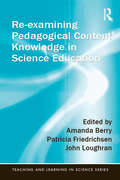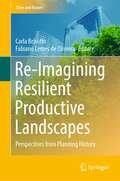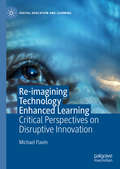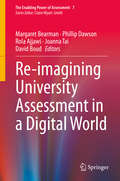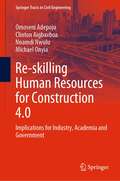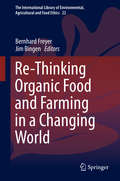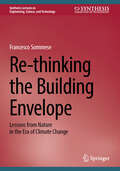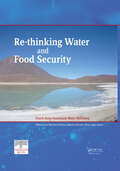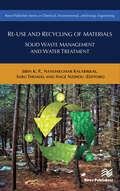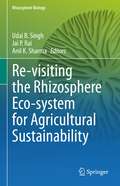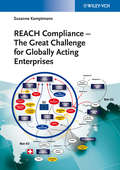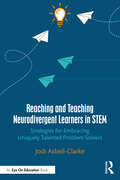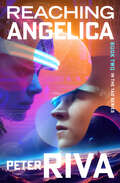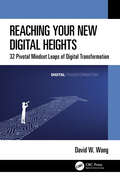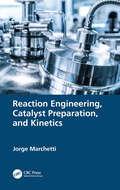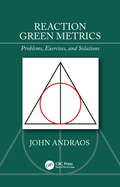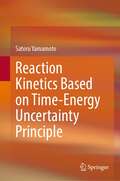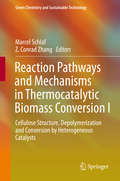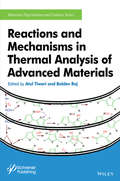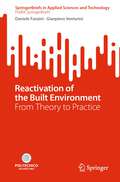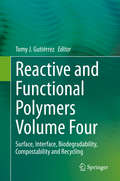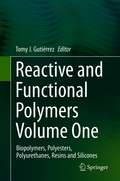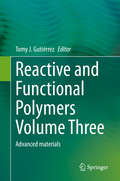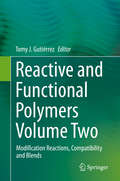- Table View
- List View
Re-examining Pedagogical Content Knowledge in Science Education (Teaching and Learning in Science Series)
by Amanda Berry John Loughran Patricia FriedrichsenPedagogical Content Knowledge (PCK) has been adapted, adopted, and taken up in a diversity of ways in science education since the concept was introduced in the mid-1980s. Now that it is so well embedded within the language of teaching and learning, research and knowledge about the construct needs to be more useable and applicable to the work of science teachers, especially so in these times when standards and other measures are being used to define their knowledge, skills, and abilities. Re-examining Pedagogical Content Knowledge in Science Education is organized around three themes: Re-examining PCK: Issues, ideas and development; Research developments and trajectories; Emerging themes in PCK research. Featuring the most up-to-date work from leading PCK scholars in science education across the globe, this volume maps where PCK has been, where it is going, and how it now informs and enhances knowledge of science teachers’ professional knowledge. It illustrates how the PCK research agenda has developed and can make a difference to teachers’ practice and students’ learning of science.
Re-Imagining Resilient Productive Landscapes: Perspectives from Planning History (Cities and Nature)
by Carla Brisotto Fabiano Lemes de OliveiraThis book explores how lessons from past urban planning experiences can inform current debates on urban agriculture. Productive landscapes today have been posited as instruments for the positive transformation related to territorial fragility and abandonment, promoting social cohesion, food security and wider environmental and economic benefits. The book will re-map the way in which seeming landscape limitations and challenges can be turned into potential, innovation and a new lease of urban-rural life. It does so by drawing on significant past urban agricultural experiences in planning as vectors for new critical reflections relevant to re-igniting ideas for future envisioning of urban scenarios in which productive landscapes play fundamental transformative roles. The focus is on planning ideas and the roles of key individual planners, all of which have designed agricultural strategies for the city at some point in their careers. It intends to help us today reimagine urban-rural relationships, and the transformation of under or mis-used urban open spaces, peri-urban areas, fringe conditions and in-between spaces.
Re-imagining Technology Enhanced Learning: Critical Perspectives on Disruptive Innovation (Digital Education and Learning)
by Michael FlavinThis book analyses technology enhanced learning through the lens of Disruptive Innovation theory. The author argues that while technology has not disrupted higher education to date, it has the potential to do so. Drawing together various case studies, the book analyses established technologies through a Disruptive Innovation perspective, including virtual learning environments, and includes Wikipedia as an example of successful innovative disruption. The author also examines the disruptive potential of social media technologies and the phenomenon of user-owned technologies. Subsequently, the author explores strategic narratives for technology enhanced learning and imagines what the Disruptive University might look like in the future. This book will be valuable for scholars of technology enhanced learning in higher education as well as those looking to increase their understanding of and practice with technology enhanced learning.
Re-imagining University Assessment in a Digital World (The Enabling Power of Assessment #7)
by Margaret Bearman David Boud Rola Ajjawi Phillip Dawson Joanna TaiThis book is the first to explore the big question of how assessment can be refreshed and redesigned in an evolving digital landscape. There are many exciting possibilities for assessments that contribute dynamically to learning. However, the interface between assessment and technology is limited. Often, assessment designers do not take advantage of digital opportunities. Equally, digital innovators sometimes draw from models of higher education assessment that are no longer best practice. This gap in thinking presents an opportunity to consider how technology might best contribute to mainstream assessment practice.Internationally recognised experts provide a deep and unique consideration of assessment’s contribution to the technology-mediated higher education sector. The treatment of assessment is contemporary and spans notions of ‘assessment for learning’, measurement and the roles of peer and self within assessment. Likewise the view of educational technology is broad and includes gaming, learning analytics and new media. The intersection of these two worlds provides opportunities, dilemmas and exemplars. This book serves as a reference for best practice and also guides future thinking about new ways of conceptualising, designing and implementing assessment.
Re-skilling Human Resources for Construction 4.0: Implications for Industry, Academia and Government (Springer Tracts in Civil Engineering)
by Omoseni Adepoju Clinton Aigbavboa Nnamdi Nwulu Michael OnyiaThis book examines the burgeoning revolution in the construction industry known as Construction 4.0, the attendant need for re-skilling human resources, and key stakeholders' roles in developing the required skills for Construction 4.0. It views the lack of 21st-century skills and skills gap in the industry as significant challenges limiting the uptake and implementation of Construction 4.0 technologies, especially in developing countries. In order to determine the skills required, this book examines the critical technologies of Construction 4.0, such as building information modelling (BIM), robotic construction, 3D printing and drones, which have transformed the construction industry, thereby creating digital, intelligent and sustainable construction solutions. Furthermore, the book considers the benefits, risks and relevant skills required to implement Construction 4.0 technologies.
Re-Thinking Organic Food and Farming in a Changing World
by Bernhard Freyer Jim BingenThis book is based on the assumption that "organic has lost its way". Paradoxically, it comes at a time when we witness the continuing of growth in organic food production and markets around the world. Yet, the book claims that organic has lost sight of its first or fundamental philosophical principles and ontological assumptions. The collection offers empirically grounded discussions that address the principles and fundamental assumptions of organic farming and marketing practices. The book draws attention to the core principles of organic and offers different clearly articulated and well-defined conceptual frameworks that offer new insights into organic practices. Divided into five parts, the book presents new perspectives on enduring issues, examines standards and certification, gives insights into much-discussed and additional market and consumer issues, and reviews the interplay of organic and conventional farming. The book concludes with a framework for rethinking ethics in the organic movement and reflections on the positioning of organic ethics.
Re-thinking the Building Envelope: Lessons from Nature in the Era of Climate Change (Synthesis Lectures on Engineering, Science, and Technology)
by Francesco SommeseThis book illustrates the potential of nature when it comes to rethinking the role of the building envelope, which is responsible for energy flows between the internal and external environment, in the era of climate change. Nature has always inspired architects and engineers in the design of structures and buildings, but its role has been limited to a simple morphological imitation with aesthetic value. Today, however, thanks to the biomimetic discipline, which imitates the functional processes of nature, it is possible to transfer nature's adaptive strategies to architecture and promote the design of buildings and architectural structures that adapt to the surrounding context and respond passively to environmental changes. The use of advanced and innovative technologies, combined with the use of smart and self-responsive materials, favours the creation of adaptive and responsive dynamic envelopes, capable of adapting their performance to the changing conditions of the environment. In this way, the envelope is no longer seen as a static element, but as dynamic and able to adapt to its context by playing an active role. After establishing a general framework for the climate adaptive building envelope and analysing the adaptation strategies of natural organisms, this book provides an overview of the biomimetic discipline applied to architecture and building technology. The analysis of emblematic and recent case studies, together with advanced techniques and materials and the illustration of biomimetic design methods, gives this text an added value that promotes the understanding of the different phases necessary to move from nature to architectural technologies. This book is an indispensable tool for researchers in the field to understand an innovative and advanced concept that meets the needs of the time. In addition, it can also help façade manufacturers to understand the current directions of scientific-academic research in order to propose new technologies to the market.
Re-thinking Water and Food Security: Fourth Botin Foundation Water Workshop
by Luis Martínez-Cortina Alberto Garrido Elena López-GunnThis book provides an overview, by leading world experts, on key issues in global water and food security. The book is divided in a series of over-arching themes and sections. The first part of the book provides an overview of water and food security. The second and third sections look at global trade and virtual water trade, and provide some
Re-Use and Recycling of Materials: Solid Waste Management and Water Treatment (River Publishers Series In Chemical, Environmental, And Energy Engineering Ser.)
by Jibin K. P. Nandakumar Kalarikkal Sabu Thomas Ange NzihouIn recent years, a considerable amount of effort has been devoted, both in industry and academia, towards the recycling and reuse of materials. Most nations are now trying to reduce the amount of waste materials, through the proper recycling of materials.Re-Use and Recycling of Materials will help readers to understand the current status in the field of waste management, as well as what research is taking place to deal with such issues.Technical topics discussed in the book include: Municipal solid waste management Recycling of WEEE Waste to industrially important product like lignin and cellulose Recycling of agriculture waste Polymer and plastic recycling
Re-visiting the Rhizosphere Eco-system for Agricultural Sustainability (Rhizosphere Biology)
by Udai B. Singh Jai P. Rai Anil K. SharmaThe present book entitled, “Re-visiting the Rhizosphere Eco-system for Agricultural Sustainability” written by experts in the field, provides a comprehensive and consolidated state-of art overview of various aspects of rhizosphere biology, ecology and functioning. The role of rhizosphere microbial diversity in enhancing plant health and plant-microbe beneficial symbioses is discussed. Main topics include the diversity of plant-associated microbes in the rhizosphere, below-ground communication among the plant, soil, insects and microbes, rhizosphere ecosystem functioning, rhizosphere engineering, recruitment of microorganisms in the rhizosphere, mycorrhizal fungal symbiosis, positive interaction of the plants with the beneficial soil microorganisms for inducing the plant growth, conferring abiotic and biotic stress tolerance and modulating several pathways of the plants for the proper establishment and revitalization in the degraded and contaminated soils or negative likes the host-pathogen interactions leading to the disease development in plants. Further chapters focus on the role of signaling during the different stages of the plant-microbe coexistence, in symbiotic or pathogenic relationships, in quorum sensing, microbial signaling and cross-talk, bio-film formation, and antimicrobial peptides. The book also discusses the application of microbes in biodegradation of xenobiotic contaminants, bioremediation of heavy metals, sustainable agriculture and soil health, biological control of insect pests and plant pathogens, and the latest tools of omics which offer pioneering approaches to the exploration of microbial structure and function, secretome, holobiome, below-ground interaction, and microbial cooperation for sustainable food production and enhanced resource acquisition. Descriptions of cutting-edge techniques and novel approaches make this book unique in the area of rhizosphere biology. This is a useful reading material for researchers and students of microbiology, agriculture, ecology, and rhizosphser studies.
REACH Compliance
by Susanne KamptmannThe only book to not only discuss the technicalities of the European REACH chemicals registration process, but also to directly address the resulting business risks and business solutions.In this text for practitioners, the author pulls together the key knowledge needed to successfully run a business under REACH, distilling thousands of pages of official documentation, and incorporating experiences from different-sized enterprises in a global context.Starting with the basics of the REACH framework, she explains the entire process on how to register with the European ECHA office with a particular emphasis on small and medium-sized businesses. Along the way, she describes key milestones and presents sample documents from real case studies. The final part of the book addresses strategies to ensure a reach-compliant operation, including recommendations for in-house processes as well as communicating with suppliers and downstream users.As a result, managers in the pharmaceuticals and chemicals industries will learn how to operate their companies in full compliance with REACH standards.
Reaching and Teaching Neurodivergent Learners in STEM: Strategies for Embracing Uniquely Talented Problem Solvers
by Jodi Asbell-ClarkeProviding salient stories and practical strategies, this book empowers educators to embrace the unique talents of neurodivergent learners in science, technology, engineering, and mathematics (STEM). An exploration of the exciting opportunities neurodiversity presents to build an innovative workforce is grounded in a large body of research from psychology, neuroscience, and education. Author Jodi Asbell-Clarke presents individual examples of neurodivergent journeys in STEM to establish evidence-based connections between neurodiversity and the types of innovative problem-solving skills needed in today’s workforce. The featured stories come directly from the author’s many years in inclusive classrooms with STEM teachers along with interviews from many neurodivergent professionals in STEM. Teachers will learn how to embrace the unique brilliance and potential of the neurodivergent learners in their classroom, working against historic marginalization and deficit-based perspectives of neurodiversity within the education system. Featuring illustrations of classroom-designed tools and materials alongside basic strategies to support executive function and emotion in learning, this book will help you nurture the talents of your neurodivergent learners and recognize their unique potential within STEM. Ideal for K-12 classroom teachers, special educators, learning specialists, psychologists, and school administrators.
Reaching Angelica (The Tag Series)
by Peter RivaIn this science fiction sequel to The Path, the crew of a ship bound to colonize another planet must first save the universe from a deadly entity. Life has changed for computer wrangler Simon Bank when he awakens from a hundred-year coma. To start, he&’s on board a massive spaceship on a mission to colonize Alpha Centauri B. The crew includes his former adversary Cramer, a computer entity named Ra (now in a human form and going by Aten), and a telepathic dog named Zip. Everyone believes Simon is a hero, and there&’s no time to disagree . . . Simon accidentally awakened a powerful entity that believes human life to be a virus worthy of annihilation. Before it destroys all life on Earth and the spaceship, Simon must find a way to stop it. Once again, Simon must rely on his computer skills and his motley group of friends to save the universe before his crew finds themselves on a journey to nowhere . . . Praise for The Path&“Excellently mixes both empathic human behavior with high-tech sci-fi knowledge in a complex main character that holds up a mirror to all of us human beings.&” —Bavo Dhooge, Diamond Bullet Award–winning author of Styx
Reaching Students: What Research Says About Effective Instruction in Undergraduate Science and Engineering
by Nancy KoberThe undergraduate years are a turning point in producing scientifically literate citizens and future scientists and engineers. Evidence from research about how students learn science and engineering shows that teaching strategies that motivate and engage students will improve their learning. So how do students best learn science and engineering? Are there ways of thinking that hinder or help their learning process? Which teaching strategies are most effective in developing their knowledge and skills? And how can practitioners apply these strategies to their own courses or suggest new approaches within their departments or institutions? Reaching Students strives to answer these questions. Reaching Students presents the best thinking to date on teaching and learning undergraduate science and engineering. Focusing on the disciplines of astronomy, biology, chemistry, engineering, geosciences, and physics, this book is an introduction to strategies to try in your classroom or institution. Concrete examples and case studies illustrate how experienced instructors and leaders have applied evidence-based approaches to address student needs, encouraged the use of effective techniques within a department or an institution, and addressed the challenges that arose along the way. The research-based strategies in Reaching Students can be adopted or adapted by instructors and leaders in all types of public or private higher education institutions. They are designed to work in introductory and upper-level courses, small and large classes, lectures and labs, and courses for majors and non-majors. And these approaches are feasible for practitioners of all experience levels who are open to incorporating ideas from research and reflecting on their teaching practices. This book is an essential resource for enriching instruction and better educating students.
Reaching Your New Digital Heights: 32 Pivotal Mindset Leaps of Digital Transformation
by David W. WangThe 4th Industrial Revolution is here, and it is the catalyst of our mindset changes as we are facing a new world of digital transformation. Mindset stands for our outlook, attitudes, and behaviors toward the world. Now that the world is rapidly changing due to technological advances, our mindset needs to leap with the trend and enable us to excel in the new digital era. Many books may have touched on the subject of digital mindset but this book takes it to a new level. The new Cognitive Model of Digital Transformation, introduced in and followed by this book, is dedicated to digital mindset leaps from key concepts and comparative approaches to best practices. The Cognitive Model of Digital Transformation categorizes the process of digital mindset leaps into five different layers, from Layer 1 as the foundation or starting key concepts, Layer 2 for digital ways of thinking, Layer 3 on digital behaviors and capabilities, Layer 4 on digital transformation, all the way to Layer 5 of wisdomin digital space, walking through the entire journey of digital mindset leaps. This book intends to help get your mindset adapted and ready to navigate digital transformation along the right track. Enjoy this book and its amazing journey of digital mindset leaps.
Reaction Engineering, Catalyst Preparation, and Kinetics
by Jorge MarchettiThis book serves as an introduction to the subject, giving readers the tools to solve real-world chemical reaction engineering problems. It features a section of fully solved examples as well as end of chapter problems. It includes coverage of catalyst characterization and its impact on kinetics and reactor modeling. Each chapter presents simple ideas and concepts which build towards more complex and realistic cases and situations. Introduces an in-depth kinetics analysis Features well developed sections on the major topics of catalysts, kinetics, reactor design, and modeling Includes a chapter that showcases a fully worked out example detailing a typical problem that is faced when performing laboratory work Offers end of chapter problems and a solutions manual for adopting professors Aimed at advanced chemical engineering undergraduates and graduate students taking chemical reaction engineering courses as well as chemical engineering professionals, this textbook provides the knowledge to tackle real problems within the industry.
Reaction Green Metrics: Problems, Exercises, and Solutions
by John AndraosThis book contains a series of exercises and problems posed in the subject of green metrics. Essentially it is a "how to" book on evaluating the material efficiency, environmental impact, safety-hazard impact, and energy efficiency of any kind of chemical reaction or synthesis plan. Only the essential green metrics in each of these categories are used. The introduction highlights the hierarchy of metrics used throughout the book, explains the structure of how the book is arranged, how the problems are posed, and how the reader is to use the book. Examples refer to themes according to the headings given in the table of contents and are arranged in a hierarchical order.
Reaction Kinetics Based on Time-Energy Uncertainty Principle
by Satoru YamamotoThis book proposes a completely unique reaction kinetics theory based on the uncertainty principle of quantum mechanics; the physical viewpoint and mathematical details for the theory construction are explained, and abundant applications of the theory mainly in materials science are described. The theory argues that physical systems on reaction are in a quantum-mechanically uncertain state, and that such systems will transition to new states after a finite duration time. Based on this theory, if the magnitude of the energy uncertainty, i.e., energy fluctuation of the system on reaction can be determined, we can calculate the reaction rates not only for the thermal activation processes but also for the non-thermal activation process such as mechanical, optical, electromagnetic, or other actions. Therefore, researchers or engineers who are involved in fields such as the discovery of new chemical substances, development of materials, innovation of manufacturing processes, and also everyone purely interested in kinetic methodology find this book very stimulating and motivating.
Reaction Pathways and Mechanisms in Thermocatalytic Biomass Conversion II
by Z. Conrad Zhang Marcel SchlafVolume II presents the latest advances in catalytic hydrodeoxygenation and other transformations of some cellulosic platform chemicals to high value-added products. It presents the theoretical evaluation of the energetics and catalytic species involved in potential pathways of catalyzed carbohydrate conversion, pathways leading to the formation of humin-based by-products, and thermal pathways in deriving chemicals from lignin pyrolysis and hydrodeoxygenation. Catalytic gasification of biomass under extreme thermal conditions as an extension of pyrolysis is also discussed. Marcel Schlaf, PhD, is a Professor at the Department of Chemistry, University of Guelph, Canada. Z. Conrad Zhang, PhD, is a Professor at the Dalian Institute of Chemical Physics, Chinese Academy of Sciences, China.
Reactions and Mechanisms in Thermal Analysis of Advanced Materials
by Baldev Raj Atul TiwariStrong bonds form stronger materials. For this reason, the investigation on thermal degradation of materials is a significantly important area in research and development activities. <P><P>The analysis of thermal stability can be used to assess the behavior of materials in the aggressive environmental conditions, which in turn provides valuable information about the service life span of the materiel. Unlike other books published so far that have focused on either the fundamentals of thermal analysis or the degradation pattern of the materials, this book is specifically on the mechanism of degradation of materials. The mechanism of rapturing of chemical bonds as a result of exposure to high-temperature environment is difficult to study and resulting mechanistic pathway hard to establish. Limited information is available on this subject in the published literatures and difficult to excavate. Chapters in this book are contributed by the experts working on thermal degradation and analysis of the wide variety of advanced and traditional materials. Each chapter discusses the material, its possible application, behavior of chemical entities when exposed to high-temperature environment and mode and the mechanistic route of its decomposition. Such information is crucial while selecting the chemical ingredients during the synthesis or development of new materials technology.
Reactivation of the Built Environment: From Theory to Practice (SpringerBriefs in Applied Sciences and Technology)
by Daniele Fanzini Gianpiero VenturiniThe book deals with urban reactivation, a particular form of regeneration intervention which in addition to the physical-spatial dimension of the places also—and above all—considers the social and relational dynamics that the intervention is able to activate. In this sense, the concept of activation (or reactivation) emphasizes the act of putting something into or back into operation, whether it concerns the material components of a container (a building or a place) or the immaterial components of a content (a need, or a function), starting from the exploitation of opportunities that the architectural project contributes to revealing, developing and accompanying.
Reactive and Functional Polymers Volume Four: Surface, Interface, Biodegradability, Compostability and Recycling
by Tomy J. GutiérrezReactive and functional polymers are manufactured with the aim of improving the performance of unmodified polymers or providing functionality for different applications. These polymers are created mainly through chemical reactions, but there are other important modifications that can be carried out by physical alterations in order to obtain reactive and functional polymers. This volume presents a comprehensive analysis of these reactive and functional polymers. Reactive and Functional Polymers Volume Four considers surface interactions, modifications and reactions, as well as reactive processes for recycling polymers and their biodegradability and compostability. World renowned researchers from Argentina, Austria, China, Egypt, France, Iran, Italy, Nepal and United States have participated in this book. With its comprehensive scope and up-to-date coverage of issues and trends in Reactive and Functional Polymers, this is an outstanding book for students, professors, researchers and industrialists working in the field of polymers and plastic materials.
Reactive and Functional Polymers Volume One: Biopolymers, Polyesters, Polyurethanes, Resins and Silicones
by Tomy J. GutiérrezReactive and functional polymers are manufactured with the aim of improving the performance of unmodified polymers or providing functionality for different applications. These polymers are created mainly through chemical reactions, but there are other important modifications that can be carried out by physical alterations in order to obtain reactive and functional polymers. This volume presents a comprehensive analysis of these reactive and functional polymers. Reactive and Functional Polymers Volume One provides the principles and foundations for the design, development, manufacture and processing of reactive and functional polymers based primarily on biopolymers, polyesters and polyurenthanes. The text provides an in-depth review of updated sources on reactive resins and silicones. In this book, world-renowned researchers have participated, including Dr. Runcang Sun (Associate editor for the journal ‘Carbohydrate Polymers’). With its comprehensive scope and up-to-date coverage of issues and trends in Reactive and Functional Polymers, this is an outstanding book for students, professors, researchers and industrialists working in the field of polymers and plastic materials.
Reactive and Functional Polymers Volume Three: Advanced materials
by Tomy J. GutiérrezReactive and functional polymers are manufactured with the aim of improving the performance of unmodified polymers or providing functionality for different applications. These polymers are created mainly through chemical reactions, but there are other important modifications that can be carried out by physical alterations in order to obtain reactive and functional polymers. This volume presents a comprehensive analysis of these reactive and functional polymers. Reactive and Functional Polymers Volume Three considers advanced polymeric materials such as electroactive polymers, multi-responsive polymers, shape memory polymers, stimuli responsive polymers, and active and intelligent polymers as topics for analysis. World renowned researchers from Argentina, Austria, China, Egypt, France, India, Iran, Japan, Pakistan, Romania and Spain have participated in this book. With its comprehensive scope and up-to-date coverage of issues and trends in Reactive and Functional Polymers, this is an outstanding book for students, professors, researchers and industrialists working in the field of polymers and plastic materials.
Reactive and Functional Polymers Volume Two: Modification Reactions, Compatibility and Blends
by Tomy J. GutiérrezReactive and functional polymers are manufactured with the aim of improving the performance of unmodified polymers or providing functionality for different applications. These polymers are created mainly through chemical reactions, but there are other important modifications that can be carried out by physical alterations in order to obtain reactive and functional polymers. This volume presents a comprehensive analysis of these reactive and functional polymers. Reactive and Functional Polymers Volume Two considers the coupling, crosslinking and grafting reactions to improve the compatibility of reactive and functional polymer blends. In this book, world-renowned researchers have participated, including Dr. Sabu Thomas (Editor-in-chief for the journal ‘Nano-Structures & Nano-Objects’). With its comprehensive scope and up-to-date coverage of issues and trends in Reactive and Functional Polymers, this is an outstanding book for students, professors, researchers and industrialists working in the field of polymers and plastic materials.
